Park volunteering offers an anxiety-friendly way to engage in nature-based community service. You'll find various low-pressure tasks like trail maintenance, wildlife monitoring, and gardening that allow you to connect with nature at your own pace. Communicate your needs to coordinators for accommodations and choose between solo or group activities based on your comfort level. Prepare for your volunteer day by packing essentials and arriving early to acclimate. During your work, use deep breathing exercises and take breaks as needed. As you contribute to park conservation, you'll build confidence, improve mental resilience, and celebrate personal growth. Discover how outdoor service can transform your well-being and community impact.
Understanding Anxiety in Outdoor Settings
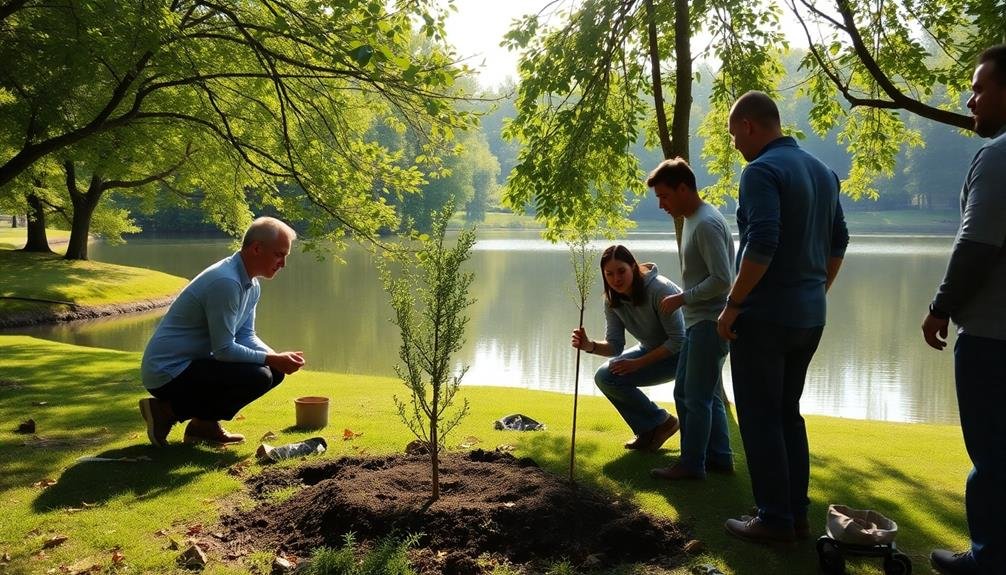
Many people with anxiety find outdoor settings challenging. You might experience heightened sensations, unpredictable environmental factors, and social pressures that can trigger anxiety symptoms. In parks, you may encounter open spaces, unfamiliar terrain, or large crowds that intensify feelings of unease.
Common anxiety triggers in outdoor settings include fear of getting lost, concern about wildlife encounters, worry about weather changes, and apprehension about interacting with strangers. You might also feel overwhelmed by sensory stimuli like bright sunlight, loud noises, or strong scents.
Understanding these challenges is essential for creating anxiety-friendly park volunteering opportunities. You'll need to recognize that anxiety manifests differently for each person, and what feels comfortable for one volunteer may be stressful for another. By acknowledging these individual differences, park organizers can develop strategies to accommodate various anxiety levels.
To make outdoor settings more accessible, consider offering orientation sessions, providing detailed maps and information, creating quiet zones, and allowing flexible schedules. You can also implement buddy systems and offer anxiety management resources to help volunteers feel more supported and prepared for their outdoor experiences.
Benefits of Park Volunteering
When you volunteer at a park, you're not just helping the environment; you're also boosting your physical and mental health.
You'll engage in activities that can improve your fitness, reduce stress, and enhance your overall well-being.
Additionally, park volunteering offers numerous opportunities to develop new skills, from plant identification to trail maintenance, which can be valuable in various aspects of your life.
Physical and Mental Health
Volunteering in parks offers a wealth of physical and mental health benefits for those with anxiety. You'll engage in light to moderate physical activity as you perform tasks like planting trees, clearing trails, or picking up litter. This regular exercise can help reduce stress, improve cardiovascular health, and boost your overall fitness level.
Being outdoors in nature has a calming effect on your mind. You'll breathe in fresh air, soak up vitamin D from sunlight, and surround yourself with greenery, all of which can lower cortisol levels and alleviate anxiety symptoms. The peaceful environment of parks can also promote mindfulness, allowing you to focus on the present moment and quiet racing thoughts.
Volunteering provides a sense of purpose and accomplishment, which can improve your self-esteem and mood. You'll meet like-minded individuals, potentially forming new friendships and expanding your support network. These social connections can help combat feelings of isolation often associated with anxiety.
Additionally, the structured nature of volunteer activities can provide a comforting routine, giving you a sense of stability and predictability that may ease anxiety-related worries.
Skill Development Opportunities
Park volunteering regularly offers a diverse range of skill development opportunities. You'll find chances to enhance both hard and soft skills that can benefit you in various aspects of life.
For instance, you might learn about local flora and fauna, gaining valuable knowledge about ecosystems and conservation. This newfound expertise can be applied to gardening, hiking, or even future career paths in environmental sciences.
You'll also improve your communication skills as you interact with park visitors, fellow volunteers, and staff members. These interactions can help you become more confident in public speaking and customer service.
Additionally, you'll likely develop leadership abilities by taking on responsibilities or guiding others in group activities.
Many park volunteer roles involve hands-on tasks, allowing you to acquire practical skills like trail maintenance, construction, or equipment operation. You might learn to use tools effectively or master techniques for preserving natural habitats.
Furthermore, you'll enhance your problem-solving abilities as you tackle challenges that arise during your volunteer work. These skills are transferable to many professional settings and can boost your resume.
Ultimately, park volunteering provides a unique platform for personal growth and skill acquisition in a supportive, nature-based environment.
Choosing the Right Park Program
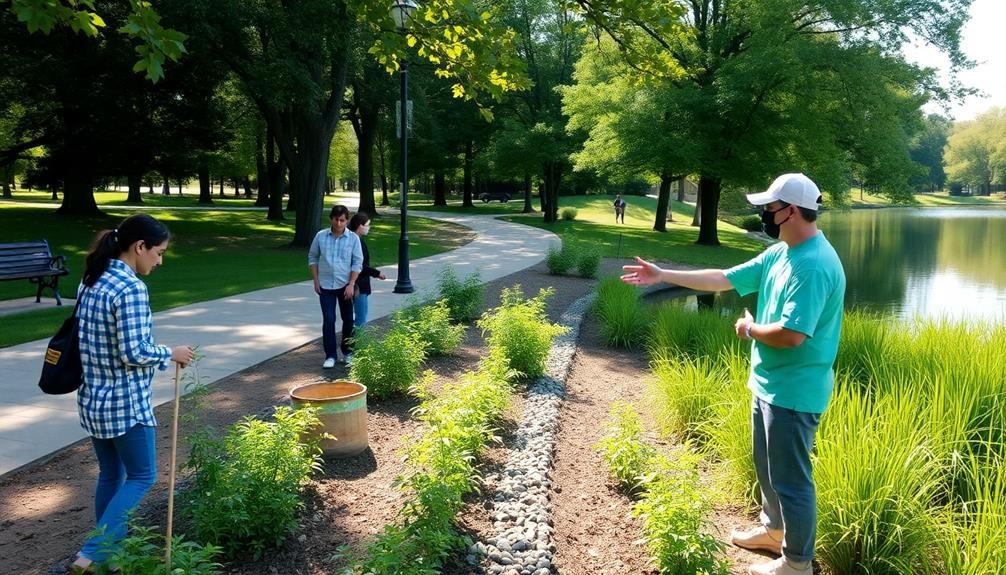
Carefully selecting the right park program is essential for a positive volunteering experience, especially if you have anxiety. Consider your comfort level, skills, and interests when choosing a program. Look for opportunities that align with your strengths and provide a supportive environment.
Research different parks and their volunteer programs. You'll find various options, from nature conservation to visitor services. Contact park coordinators to discuss available positions and any accommodations you might need.
Here's a comparison of common park volunteer roles:
| Role | Interaction Level | Physical Demand | Skill Required | Outdoors % |
|---|---|---|---|---|
| Trail Maintenance | Low | High | Low | 100% |
| Visitor Center | High | Low | Medium | 0% |
| Wildlife Monitoring | Low | Medium | High | 80% |
| Event Planning | Medium | Low | High | 20% |
| Garden Maintenance | Low | Medium | Low | 100% |
Choose a role that matches your comfort zone. If you prefer minimal social interaction, trail maintenance or wildlife monitoring might be ideal. For those who enjoy engaging with others, visitor center or event planning roles could be suitable. Remember, you can always start with less demanding tasks and gradually increase your involvement as you become more comfortable.
Solo vs. Group Volunteer Options
When considering park volunteer opportunities, you'll often have the choice between solo and group activities.
Solo options can be ideal for those who prefer working independently or need more control over their environment. These might include tasks like trail maintenance, wildlife monitoring, or plant identification. You'll have the freedom to set your own pace and take breaks as needed, which can be especially beneficial if you're managing anxiety.
Group volunteer options, on the other hand, offer social interaction and shared experiences. These can include guided nature walks, community clean-up events, or educational programs.
While potentially more challenging for those with social anxiety, group activities provide opportunities to connect with like-minded individuals and build a sense of community. You might find that working alongside others helps distract from anxious thoughts and creates a supportive atmosphere.
Consider your comfort level and anxiety triggers when choosing between solo and group options. Some parks offer a mix of both, allowing you to gradually shift from individual tasks to group activities as you become more comfortable.
Don't hesitate to communicate your preferences and needs to the volunteer coordinator, as they can help tailor your experience to suit your comfort level.
Low-Pressure Tasks for Anxious Volunteers
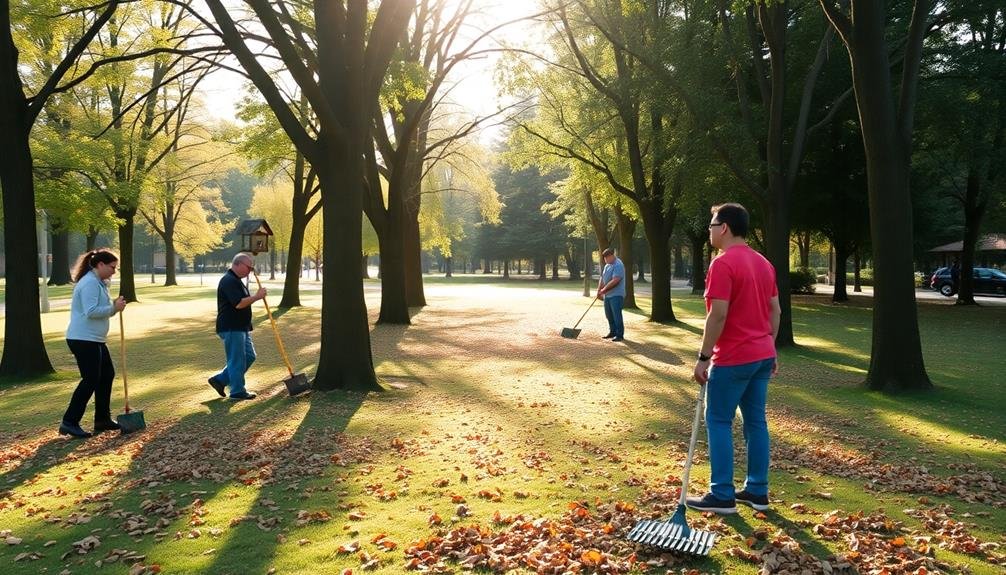
For anxious volunteers, low-pressure tasks can provide a gentle introduction to park stewardship. These activities allow you to contribute meaningfully without feeling overwhelmed or exposed.
You'll find that many parks offer opportunities that don't require extensive social interaction or high-stress situations.
Consider these low-pressure tasks that are well-suited for anxious volunteers:
- Trail maintenance: Clear debris, prune overgrown vegetation, or repaint trail markers
- Litter pickup: Work at your own pace to collect trash in designated areas
- Native plant care: Water, weed, or mulch around newly planted trees and shrubs
- Wildlife habitat improvement: Build birdhouses, bat boxes, or create brush piles
- Data collection: Record plant or animal sightings for biodiversity surveys
These tasks often allow you to work independently or in small groups, giving you control over your social interactions.
You'll also have the flexibility to take breaks when needed. Remember, park staff are usually understanding and can accommodate your needs.
Don't hesitate to communicate your preferences or concerns. By starting with these low-pressure activities, you can gradually build confidence and potentially explore more challenging volunteer roles in the future.
Communicating Your Needs to Coordinators
When communicating with park volunteer coordinators, it's essential to express your anxiety-related limitations clearly.
You can request specific accommodations that will help you feel more comfortable and successful in your role.
Don't hesitate to discuss flexible options with coordinators, as they're often willing to work with you to find tasks that suit your needs and abilities.
Express Limitations Clearly
Clear communication is key when discussing your needs and limitations with volunteer coordinators. When expressing your limitations, be specific about what tasks you can and can't do. For example, if crowds trigger your anxiety, let them know you prefer solitary or small group activities. If certain physical tasks are challenging, explain which ones and why.
Don't hesitate to ask questions about the volunteer roles to confirm you understand what's expected.
Remember, it's okay to set boundaries. If you need breaks or a quiet space to recharge, communicate this upfront. Be honest about your availability and the duration you can commit to. If you're unsure about a task, express your willingness to try but ask for patience and guidance.
- State your comfort level with different environments
- Explain any triggers that might affect your performance
- Describe your preferred working style (solo, paired, or group)
- Mention any accommodations that would help you succeed
- Share your strengths and areas where you excel
Request Specific Accommodations
Requesting specific accommodations is an essential step in ensuring a positive volunteer experience. When you've identified your limitations, it's time to communicate your needs to the park volunteer coordinators. Be clear and specific about what accommodations would help you feel more comfortable and perform your tasks effectively.
Consider these common accommodations and how they might apply to your situation:
| Accommodation Type | Examples | Benefits |
|---|---|---|
| Schedule Flexibility | Shorter shifts, specific time slots | Reduces overwhelm, allows for breaks |
| Task Modification | Solo work options, less public-facing roles | Minimizes social anxiety triggers |
| Environmental Adjustments | Quiet work areas, access to shade | Reduces sensory overload, improves comfort |
Don't hesitate to ask for what you need. Coordinators are often willing to work with you to find solutions. If possible, suggest alternatives or compromises that could meet both your needs and the park's requirements. Remember, being upfront about your needs helps create a more inclusive volunteering environment for everyone. By advocating for yourself, you're also paving the way for others with anxiety to participate in park volunteering activities.
Discuss Flexible Options
Building on the idea of requesting accommodations, it's important to explore flexible options with park volunteer coordinators. Discuss the possibility of adjusting your volunteer schedule, tasks, or environment to better suit your needs.
You might find that there are alternative ways to contribute that align more closely with your comfort level and abilities.
When talking with coordinators about flexible options, consider the following:
- Ask about remote volunteer opportunities, such as virtual trail mapping or social media support
- Inquire about shorter shifts or the ability to take breaks as needed
- Explore solo tasks that don't require constant interaction with others
- Request to work in quieter, less crowded areas of the park
- Discuss the option to switch between different roles or activities
Preparing for Your Volunteer Day
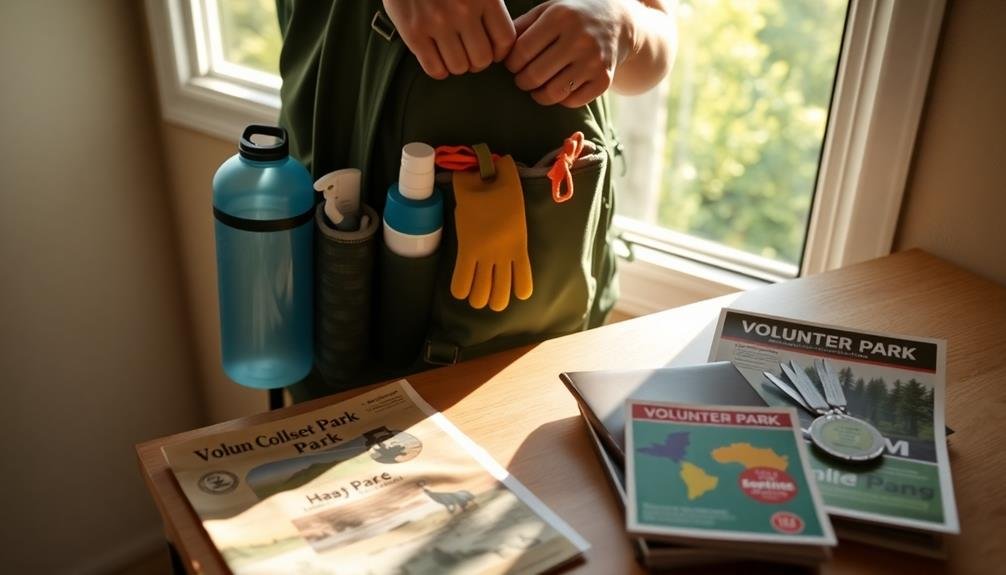
Proper preparation can make all the difference when you're gearing up for your volunteer day at the park. Start by confirming the details of your assignment, including the date, time, location, and specific tasks you'll be performing.
Pack appropriate clothing and footwear for outdoor work, considering the weather forecast and terrain. Bring essential items like water, snacks, sunscreen, insect repellent, and any personal medications you might need.
If you're prone to anxiety in new situations, consider bringing comfort items such as headphones or a stress ball. Familiarize yourself with the park's layout and facilities beforehand, noting the locations of restrooms and quiet areas where you can take breaks if needed.
Contact the volunteer coordinator to discuss any accommodations you might require due to anxiety or other concerns. Ask about the group size, structure of the day, and potential social interactions.
If possible, arrange to arrive early to acclimate to the environment and meet your supervisor before the full group arrives. Remember, it's okay to communicate your needs and take breaks when necessary.
Coping Strategies During Park Work
While engaging in park work, several effective coping strategies can help manage anxiety and guarantee a positive volunteering experience. Focus on deep breathing exercises to calm your nerves and center yourself.
If you feel overwhelmed, take short breaks to reconnect with nature and reset your mind. Remember that it's okay to work at your own pace; don't push yourself beyond your comfort zone. Communicate openly with your volunteer coordinator or team leader about any concerns or limitations you may have.
To further enhance your park volunteering experience and manage anxiety:
- Bring noise-canceling headphones or earplugs if you're sensitive to sounds
- Wear comfortable, loose-fitting clothing to avoid feeling restricted
- Carry a water bottle and healthy snacks to maintain your energy levels
- Use sunscreen and insect repellent to prevent discomfort from sun exposure or bug bites
- Bring a small comfort item, like a smooth stone or stress ball, to hold when feeling anxious
Building Confidence Through Nature Service
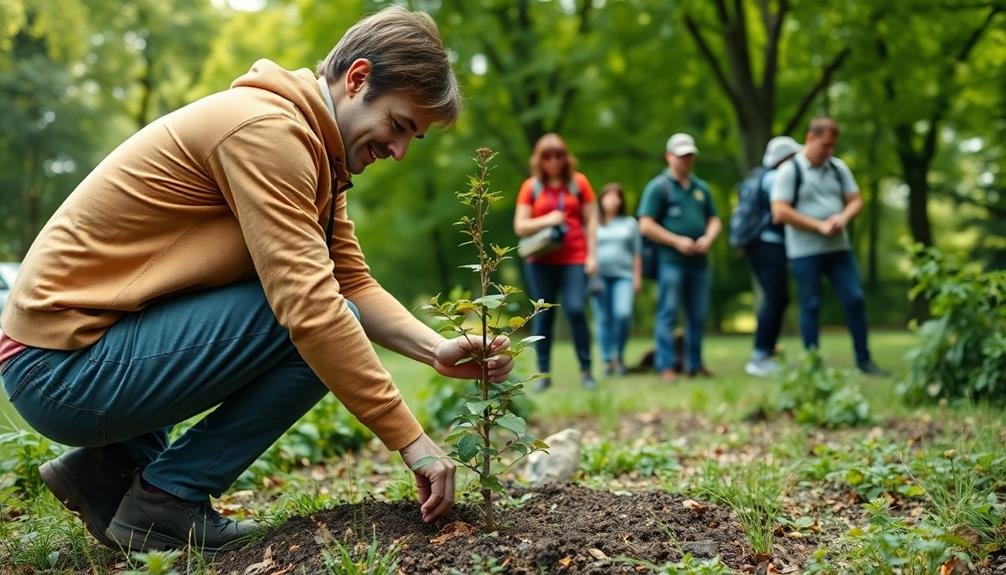
Engaging in nature service can be a powerful tool for building self-confidence. As you volunteer in parks, you'll gradually acquire new skills and knowledge about the environment. This growth process naturally boosts your self-esteem as you become more competent in your tasks.
You'll find that completing tangible projects, like trail maintenance or habitat restoration, provides a sense of accomplishment. These visible results of your efforts can greatly increase your confidence.
Additionally, working alongside others who share your passion for nature creates a supportive community where you can feel valued and appreciated.
As you interact with park visitors and share your knowledge, you'll develop better communication skills and become more comfortable in social situations. This can be especially beneficial if you struggle with social anxiety.
The outdoor setting also offers a less intimidating environment for building these skills.
Over time, you'll likely notice increased physical stamina and mental resilience from regular outdoor work. These improvements in your overall well-being can contribute to a more positive self-image and greater confidence in various aspects of your life.
Celebrating Small Victories in Volunteering
As you engage in park volunteering, take time to acknowledge your personal growth, no matter how small it may seem.
Recognize the positive impact you're making on the environment and community with each task you complete.
Share your success stories with fellow volunteers or park staff to inspire others and reinforce your own progress.
Acknowledging Personal Growth
Throughout your park volunteering journey, it's important to recognize and celebrate your personal growth. As you overcome anxiety-related challenges and engage in various tasks, you'll likely notice improvements in your confidence, social skills, and overall well-being.
Take time to reflect on how far you've come since your first day as a volunteer. To acknowledge your progress, consider keeping a journal or sharing your experiences with a trusted friend or family member. Pay attention to the small wins, such as striking up a conversation with a fellow volunteer or successfully completing a task that once seemed intimidating.
Remember that growth isn't always linear, and it's okay to have setbacks along the way. Here are some ways to recognize your personal growth:
- Track your comfort level with different volunteer tasks over time
- Note instances where you pushed through anxiety to participate
- Identify new skills you've acquired through volunteering
- Reflect on positive interactions with others in the park
- Acknowledge moments when you felt proud of your contributions
Recognizing Positive Impact
Recognizing your positive impact as a park volunteer is just as important as acknowledging personal growth. As you contribute to park maintenance and conservation efforts, you're making a tangible difference in your community.
Take note of the improvements you've helped create, whether it's a cleaner trail, a restored habitat, or a more welcoming visitor area.
You'll often see immediate results from your work, like removing invasive plants or clearing litter. These visible changes can boost your confidence and reinforce the value of your efforts.
Don't overlook the long-term effects either, such as increased biodiversity or enhanced recreational opportunities for park visitors.
Your presence alone can inspire others to get involved. By sharing your experiences with friends and family, you're raising awareness about environmental stewardship and community service.
Remember that every task you complete, no matter how small, contributes to the park's overall health and beauty.
Celebrate these achievements, both big and small. They're proof of your commitment and the positive influence you're having on your local environment and community.
Sharing Success Stories
Despite the anxiety you may feel, sharing your success stories as a park volunteer can be incredibly rewarding. It's not just about bragging; it's about inspiring others and reinforcing your own progress.
When you share your experiences, you're contributing to a supportive community and encouraging others who might be hesitant to volunteer due to anxiety.
Start small by sharing with fellow volunteers or park staff. As you become more comfortable, consider posting on social media or contributing to the park's newsletter.
Remember, every small victory counts, whether it's completing your first shift, learning a new skill, or overcoming a specific fear.
Here are some ways to share your success stories:
- Write a brief testimonial for the park's website
- Post a photo of your volunteer work on Instagram
- Share a personal anecdote during a volunteer meeting
- Create a short video about your experience for TikTok
- Submit an article to a local newspaper about park volunteering
Frequently Asked Questions
Are There Age Restrictions for Anxiety-Friendly Park Volunteering Programs?
You'll find age restrictions vary by program. Many accept volunteers 16 and up, while some welcome families with younger children. It's best to check with specific organizations for their age requirements and any guardian policies.
Can I Bring a Support Animal to My Park Volunteering Sessions?
You'll need to check with the specific park's policy on support animals. Many places allow them, but you should ask in advance. Make certain your animal is well-behaved and won't disrupt volunteering activities or wildlife.
How Often Are Anxiety-Friendly Park Volunteering Opportunities Typically Available?
You'll find anxiety-friendly park volunteering opportunities vary by location. Some parks offer weekly sessions, while others may have monthly events. Check with your local park service or community organizations to learn about specific schedules in your area.
Is Special Clothing or Equipment Required for Anxiety-Friendly Park Volunteering?
You'll usually need comfortable clothes suitable for outdoor work. Sturdy shoes are essential. Gloves are often provided, but you can bring your own. Some tasks might require specific gear, which the organizers will typically supply.
Are There Virtual Options for Anxiety-Friendly Park Volunteering During Pandemic Restrictions?
Yes, you'll find virtual options for park volunteering during pandemic restrictions. You can participate in online nature education, virtual guided tours, social media outreach, or remote data entry. These activities support parks while keeping you safe at home.
In Summary
You've taken an important step by exploring anxiety-friendly park volunteering. Remember, it's okay to start small and go at your own pace. As you continue to engage with nature and serve your community, you'll likely find your confidence growing. Don't forget to celebrate each accomplishment, no matter how minor it may seem. With time and practice, you'll discover that park volunteering can be a rewarding and empowering experience, even with anxiety.





Leave a Reply